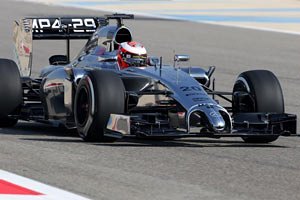turbof1 wrote:
1.
Because you have the butterfly suspension effectively blocking the transition high pressure air - low(er) pressure air, air coming out of the cooling outlet doesn't get accelerated anymore. Effectively, this slows down the velocity (compared to a non-blocking suspension, where the transition accelerates the air closer to the faster moving air). Lower velocity means higher pressure. These are simple aero rules.
2. This is also exactly the reason why mclaren wanted the butterfly suspension: it blocks this transition, creates more high pressure on top of the diffuser, and keeps the low pressure air behind the suspension low.
3. Speaking of ignoring because it doesn't fit your opinion: you haven't yet given your view on what the butterfly suspension effectively does (and please try to not quote this seperately; just put it at the end of your text). The most frustrating of all is you typically only answered in the following style: "no it isnt" "this is against physics" "this is not useful". Well if you think so, educate me instead of just dismissing it.
I hate answering everything in one piece, because it is just unclear. I try it and at least put in some numbers in your quote just not to mix things up:
Regarding point 1 you are explaining things that are very clear but still do not give the connection. I think we both know, that we are not discussing among stupids. Thus, we both know about the low pressure behind the bodywork round the cooling exits. And we both know about the blocking of the butterflies.
But now comes the point where we have the problem: You say, that the blocking is so big that it raises the pressure in the whole region between butterfly and cooling exit. For me this is wrong: The low pressure region is defined by the bodywork. Neglecting any turbulent air and the butterflies, the flow would be asymptotic to the floor behind the bodywork, defining the low pressure area, before it would be pulled upward by the upwash of wing and diffusor.
Now with the butterflies: The flow would still be asymptotic to the floor behind the bodywork in a reasonable area. Later at the butterflies it gets directed upwards/downwards.
If you wanted to destroy the low pressure zone, which is there just because the car moves, you need air coming from the butterflies.
So, still the question: How can this blocked air reach more than 10cm in front of the butterflies when the car is moving?
For me it is clear, that the low pressure zone is already destroyed far ahead of the butterflies because of the air coming from above and below the cooling air exits. Thus I think regarding point 2 the overall function of the butterflies can be seen as blocking, but in a very small region and like at every wing with a netto zero effect on the pressure in front of it. The small guides next to the crash structure are needed to extract some use from this blocking...another sign that the blocking is rather small.
Now the final point 3: I see the butterflies similar to the beam wing mainly as a device helping diffusor and rear wing upwash. Guiding hot air blown rather on their upper side into the upwash of the rear wing and producing a small low pressure zone to help the diffusor with its upwash.


